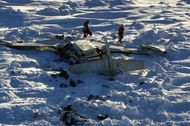The identities of two utility workers on board the Bering Aircraft that went down on February 6 close to Nome, Alaska, have been released. While traveling from Unalakleet, the plane, which was carrying nine passengers and a pilot, lost altitude and crashed into Norton Sound. As investigations attempt to identify the cause amid severe winter conditions, officials have paid tribute to their efforts.
Two of the passengers Rhone Baumgartner and Kameron Hartvigson, who work for the Alaska Native Tribal Health Consortium's (ANTHC) Division of Environmental Health and Engineering, were identified by the organization.
During the harsh winter months in the state, the men had come to Unalakleet to help with mechanical and heating problems, making sure rural inhabitants had access to necessary services.
Saddened by the death, ANTHC interim president and CEO Natasha Singh described the two as dedicated professionals who had a real impact on rural Alaska. She remarked,
“[They] were passionate about the work they did, cared deeply for the communities they served, and made a lasting impact."
Singh continued, underscoring the importance of their work for public health and safety by adding,
“They gave the ultimate sacrifice for the people we serve in the work we do,”
“Everyone at ANTHC feels a sense of shock and loss because they were so crucial to our Rural Energy and Tribal Support teams.”
Speaking about the terrible effects on the neighborhood, Unalakeet City Administrator Kelsi Ivanoff described it as: "very small, tight-knit" where any locals had personal ties to individuals on board. She emphasized the strong ties between the people who live in the state's isolated villages by saying,
“There’s definitely gonna be connections to the aircraft, to people on the aircraft."
U.S. Senator Lisa Murkowski and Governor Mike Dunleavy of Alaska also offered their condolences.
“Our prayers are with the passengers, the pilot, and their loved ones during this difficult time.”
Murkowski said,
“Alaska is a big small town. When tragedy strikes, we’re never far removed from those directly impacted.”
Alaska authorities are investigating the cause of the deadly crash

Around 3:18 p.m. on February 6, the Bering Air aircraft, a Cessna Grand Caravan, disappeared from radar, according to the Alaska Department of Public Safety(DPS). When the plane lost altitude and plunged into Norton Sound's frigid waters, it was about 34 miles southeast of Nome. All ten people on board, including the pilot, were eventually confirmed dead by the authorities.
Recovery efforts were complicated when the wreckage was found on advancing sea ice by the U.S. Coast Guard, which was in charge of search and recovery operations. Before an impending winter storm further jeopardized operations, the Nome Volunteer Fire Department moved swiftly to recover the remains.
The collision is being investigated by the National Transportation Safety Board(NTSB). The cause is still unknown, but preliminary radar data indicated that the plane lost speed and altitude, said Chairman Jennifer Homendy. Before the impact, no distress signals were registered. The search has been difficult due to the worsening weather, Homendy stated,
“Recovery efforts are still under way, with the priority being victim recovery.”
In Alaska, where there are great distances and little infrastructure, flying is a vital form of transportation. However, the risks of flying are increased by the state's harsh winters, steep terrain, and erratic weather. In the state, where small planes are used for essential cargo transportation, medical emergencies, and daily commuting, the crash is the most recent in a string of aviation disasters.
Officials continue to pay tribute to victims, especially Baumgartner and Hartvigson, who were renowned for their commitment to helping outlying areas, while investigators try to identify the cause. David Beveridge, ANTHC's vice president of environmental health and engineering, said,
“These two members of our team lost their lives serving others. The loss of these two incredible individuals and everyone else on board the plane will be felt all over Alaska.”
